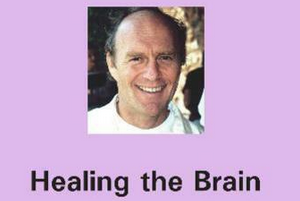Stephen Gilligan – The Problem is The Solution
$28.00
Stephen Gilligan – The Problem is The Solution
I. Introduction
In the movie “Pleasantville”, two adolescent siblings from the 1990’s find themselves transported into a 1950’s black and white TV sitcom landscape based on the old show “Father Knows Best”. While on the surface everything seems perfect, there is no depth, mystery, color, or soul in this world. Everyone lives in an enclosed “pleasant trance” devoid of real liveliness, a sort of mindless “brave new world”. The two “visitors” instigate a series of happenings that precipitate awakenings in each person, including themselves. Each awakening occurs when a person connects with a hidden or undeveloped part of his or her being. For a teenage athlete, it happens via love and romance; for the kids’ “mother”, it comes from discovering the sensuality of her body; for the father, it comes from recognizing his longings; for the girl, it comes from reading classics; for the boy, it comes from finding his fierceness. In each case, the experience and expression of undeveloped parts of one’s self transforms the person into living “color”. They and others around them have then to deal with the myriad of responses that arise in response to this awakening.
Get immediately download Stephen Gilligan – The Problem is The Solution
Pleasantville is all around us. It keeps us asleep through false smiles, violent threats, unspoken fears, disembodied thinking, numbness, consumerism, and other practices of the modern and postmodern world. A corporate woman in a poetry workshop (cited by Whyte, 1994, p. 31) once wrote:
“Ten years ago…..
I turned my face for a moment
And it became my life.”
We have all suffered those ten-year “gaps” in our lives, where we thought we were present but then, in hindsight, realized we weren’t.
The damming of life cannot continue forever. Sooner or later, the river leaks through, bringing with it a myriad of memories, dreams, and reflections. This can be a frightening time, for the fear in exile is that we will be overwhelmed, perhaps even die, if we allow these currents to wash over and through us. New defenses arise–more dissociation, more compulsive behaviors, more “playing dead”, more intellectualization, more violence against self and others—all desperate attempts to regain control and expel the “negative otherness” that presses upon us. At some point, it becomes clear that we’re losing the battle—we’re dealing with a presence stronger than our ego, and our vaunted defenses can no longer keep separate from it. In desperation, we may turn to a therapist in hopes of fortifying our ego and its defenses.
When a client visits us, how we regard the disturbances in their lives—the experiences and events that are throwing them into “organized chaos” – makes a great deal of difference. The traditional view is generally that we should help the client overcome these “pathological” forces that threaten their well being. This view regards the “problem”as an “enemy” that should be defeated, through any means possible. Milton Erickson (1980a; 1980b) pioneered an entirely different approach, one based on accepting and working with a person’s “problems” as unique presences that could, under the proper conditions, be the basis for new learning and growth. For example, a young secretary was utterly convinced that a large gap in her teeth made her ugly and undesirable. Erickson had her learn to squirt water through the gap in her teeth until she was able to hit a distant target. He then got her to lay in waiting at the office water cooler in order to “ambush” a young man (to whom she was attracted) with a squirt of water. One thing led to another, and the couple lived happily ever after.
The legacy of Milton Erickson has been elaborated and deepened in many ways in the last 20 years. My own work has moved from a more mainstream Ericksonian emphasis (see Gilligan, 1987) to the development of a neo-Ericksonian approach I call self-relations psychotherapy (see Gilligan, 1997). Like Erickson’s work, self-relations emphasizes the positive aspects of problem and symptoms. It sees such disturbances of the “normal order” as evidence that “something is waking up” in the life of a person or community. Such disturbances are double-edged crises. On the one side, they are (often hidden) opportunities for major growth. Most of us, for example, can recall negative events—a death, divorce, illness, or addiction—that led to significant positive change in our lives. On the other side, such disturbances can very destructive—we can get lost in depression, acting out, or other problematic behaviors. Self-relations suggests that the difference is in whether a disturbance can be “sponsored” by a skillful human presence.
The principle and processes of sponsorship are the cornerstone of self-relations. The word “sponsorship” comes from the Latin spons, meaning, “to pledge solemnly”. So sponsorship is a vow to help a person (including one’s self) use each and every event and experience to awaken to the goodness and gifts of the self, the world, and the connections between the two. Self-relations suggests that experiences that come into a person’s life are not yet fully human; they have no human value until a person is able to “sponsor them”. Via sponsorship, experiences and behaviors that are problematic may be realized as resources and gifts. In this way, what had been framed and experienced as a problem is recognized as a “solution”.
The motto for therapeutic sponsorship may be found on the Statue of Liberty in the New York Harbor:
Get immediately download Stephen Gilligan – The Problem is The Solution
“Give me your tired, your poor,
Your huddled masses yearning to breathe free.
The wretched refuse of your teeming shores.
Send these, the homeless, tempest-tost to me.
I lift my lamp by the golden door.”
Emma Lazarus, 1849-1887
In self-relations, this motto not only refers to people, but to experiences and behaviors as well. For example, Fred was an academic who was seeing me for what he described as “low-grade, long-time depression.” He arrived one session complaining of being “a sexual pervert.” Taking a sabbatical year off to write and to stay home with his baby son, Fred found himself downloading pornography from the Internet for up to 3 hours a day. He explained that it took him this long partly because his fear of being “caught” would not allow him to give his credit card; instead, he would search for sites featuring free “teaser pictures”, download them, and then meticulously organize them into a library that had to be constantly updated. I had been working with him for about three months on his presenting problems of feeling depressed and anxious in some work-related matters. He had let me know in general terms about the pornography interests when I previously inquired about his sexual and social life, but had strongly rebuffed my attempts to engage him around those topics.
In bringing it up now, he said it was draining his energy and he desperately wanted to do something about it. As I listened to him, I noticed that my early Catholic guilt had come back to visit me, suggesting I send Fred to Fr. McCarthy for confession, followed by a lifetime of very cold showers. I also noticed that this “suggestion” led to my feeling off-center and rigid, so I allowed it to pass. (A major benefit of both hypnosis and meditation is that it teaches you a “just let it happen” attitude toward your mind, so you can compassionately observe each thought or feeling without identification, and then decide how you’d like to proceed.). I worked to develop a receptive state in which I felt connected, open, and curious as to the positive gift that was awakening within Fred. After several minutes I became aware of what a beautiful man Fred was, something I had somehow overlooked previously. I found myself talking with him about how sexual energy is perhaps the most powerful, undefeatable energy in the world. I suggested that finding one’s deep sexual identity is a lifelong challenge that takes everything one has. I admired and complimented Fred on the amazing depth and intensity of his sexual presence, and noted that I had little confidence in his repressing it.
The relational “field” seemed filled with a deep connection, probably the most connected I’ve felt with Fred. He seemed touched and receptive to my compliments, and developed a light hypnotic state in response to them. I talked some more about how for whatever reasons, his sexuality seemed to be calling him to a deeper awareness. He agreed, but said he was scared. I acknowledged he was scared, taking special emphasis to note, “Yes, Fred, as a sexual being you are scared. “Pausing to let this stand on its own, I then asked, “As a sexual being, who else are you? “He laughed a bit nervously before saying, “I’m also very horny!” I paused to sense this part of his sexual self before feeding back, “Yes, Fred, as a sexual being you are also horny!” I then suggested he continue with further answers to the “Who am I as a sexual being?” question. It took a little coaching for Fred to settle down so he could speak, feel, hold, and make visible one sexual identity at a time. For example, he might say, “As a sexual being, I am really ashamed”, then be encouraged to let go, feel that identity in his bodymind as I fed it back and acknowledged the importance of that truth. The next one might be, “As a sexual being, I really get turned on by looking at beautiful naked female bodies”. As he spoke it, I would see it, nonverbally connect with it, gently name it, encourage him to know it, and nonverbally witness it. After ten seconds or so or silence, I would ask, “Who else are you as a sexual being?” This continued for about eight identities, including “I am….afraid, really turned on, interested in touch, numb, obsessed, paranoid, and intense. Each identity was individually sensed, felt, made visible, properly named, blessed, and allowed its special place.
Somewhere during the process, Fred looked so beautiful, the way people look in therapy when they’re no longer dissociating. It was like he somehow found a way to begin to make room and reveal the deepest parts of his sexual identity. We talked about how sexual identity had so many different emotional truths and identities enfolded within in it. I suggested that really distinguished a “pervert” from a vital, healthy sexual being was the ability to sense the relational connections between these diverse identities as well as feel the “unitary field” of self that held all of them. (For example, many identities might be contradictory, but all can have a place in the field of self.) We talked about a few technical ways (extensions of the exercise) he could practice this sponsorship of sexual identity.
Two weeks later, at the next session, Fred shared his surprise that for whatever reason, his preoccupation with Internet pornography had been virtually absent. At the same time, he started to focus on concerns for his wife and their relationship. Further sessions focused on couples work, especially in terms of the relation between intimacy and sexuality.
II. A few ideas about sponsorship
This small example provides a few hints about a number of ideas of therapeutic sponsorship. We might note three basic ideas here.
(1) There are two modes of experience: the “fressen”of nature and the “essen” of culture. In German, there are two words for eating: fressen and essen. Fressen means to eat like an animal or a pig; essen is to eat like a human being. As anybody who has raised a child can attest, the road from fressen to essen is a long one. It takes tremendous acts of sponsorship to help a child learn to eat like a person!
If we take this distinction and generalize it to other human activities, we can see that each aspect of being a person comes to us as “not ready for prime time”fressen energies. It is the “re-spons-ability”of the community to help a person develop social-cognitive relational skills to transform these energies into “essen forms” that have value to the person and the community. Thus, the fierceness that reveals itself as temper tantrums in a toddler can, if properly sponsored, developmentally progress into the admirable fierceness of the mature individual. If negatively sponsored, the same tantrums may later reveal themselves as rage, passive aggressiveness, violence, or other social forms that seem to have little or no value.
Get immediately download Stephen Gilligan – The Problem is The Solution
I discussed at length in “The courage to love” what some of these sponsorship practices involve, including the following:
centering/opening attention
deep listening/proper naming
being touched by/touching
challenging/accepting
connecting with resources and traditions
developing multiple frames/practicing behavioral skills
cultivating fierceness, tenderness, and playfulness
These practices, some of which are elaborated below, are the ways and the social/cognitive/experiential means by which a “fressen energy” is awakened into consciousness and cultivated into the human value of an “essen form”.
(2) A generative Self develops each time essen and fressen integrate. In this view, the experience of a self is arises at each moment that the “essen mind” – the cognitive self that performs meaning and value—integrates with the “fressen mind” – the somatic self organized within the archetypal, experiential language of the body. The generative Self is not a given nor it is always present: it is a dynamic realization that awakens each time the cognitive and somatic selves are cooperating. A good example of this creative/created self can be found in artists. Most artists – writers, painters, poets, dancers – emphasize that their creative energies come from some place other than their cognitive (conscious) self. The task of the artist is to find ways to receive those energies and cultivate a relationship with them. This relationship is neither one of domination nor submission—the artist neither totally “controls” the creative energy nor has “sponsor” these energies, to mid-wife them into creative form.
In the same way, each person is a performance artist. She is visited regularly by creative but chaotic life energies that are calling her to do something interesting. If she can develop sponsorship skills, these energies can take helpful forms in the social world. If not, they may become persistent, troubling feelings or behaviors—anxiety, depression, agitation, etc.
(3) Symptoms and other acts of violence arise each time essen ignores, curses, or exploits fressen energies. We can begin to see that while life flows through you, giving you everything you’ll need to become a person, your presence is deeply needed. If you do not “sponsor” the “fressen” gifts given in the moment, they will likely persist and repeat themselves with an even greater intensity. If you curse them, they will take on negative forms. If you exploit them, they will take on distorted forms. At some point they seem to be a presence greater than the social/cognitive self, a repetitive experience or behavior beyond your control. The more you try to get rid of it, the deeper it becomes entrenched. This is what we call a clinical symptom: a disturbing fressen energy that has not yet been therapeutically sponsored into a helpful essen form.
As therapists, we look for the unsponsored fressen energies. We become intently curious about the disturbing experiences and behaviors that a person feels overwhelmed by, and welcome them as the basis for creative new developments. We realize that efforts to resist or overcome these “problems” are not only futile but typically have the effect of sustaining them. As Watzlawick, Weakland, and Fisch (1974) emphasized, the attempted solution is the problem. For example, a person who tried to overcome nagging doubts by obsessive “positive thinking” became even more agitated, self-absorbed, and ineffective. Self-relations posits that the opposite is equally true: the problem is the solution. That is, what seems at first glance to be a terrible experience to be avoided at all costs is that which provides, under proper conditions and effective sponsorship, exactly what the person needs to grow and develop further. For example, the client with “nagging doubts” was invited to welcome them while in a deeply relaxed state. While doing so, he noticed a tender presence within his heart that had been ignored. Integration of this tender presence led to a more calm, centered presence; one that was neither “negative” nor “positive”.
The presence of “proper conditions and effective sponsorship” is the key here. Without them, more “ineffective suffering” (Merton, 1964) and disturbing events will be the case. So our major challenge in psychotherapy is to define and effectively create the ways and means of transformational sponsorship. I want to spend the rest of the paper speaking to a few of those possibilities.
Be the first to review “Stephen Gilligan – The Problem is The Solution” Cancel reply
Related products
NLP - Self-help - Dating
Personal Development
Personal Development
Dr. med. Dietrich Klinghardt – Healing the Brain. Seminarmittschnitt Mai 2009
Personal Development
Personal Development
NLP - Self-help - Dating
Stephen Gilligan – Demonstrating the Principles and Practices of Self-Relations Psychotherapy
Personal Development
Jon Long & Ken Dai – HSK 1 Course A – Beginner Mandarin Chinese
Business & Marketing















Reviews
There are no reviews yet.